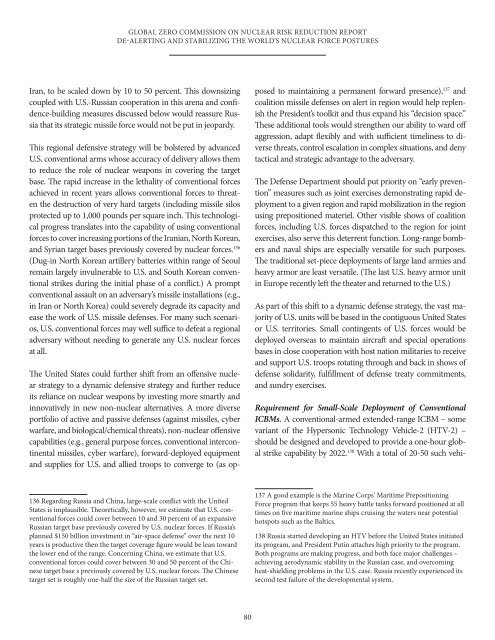global_zero_commission_on_nuclear_risk_reduction_report
global_zero_commission_on_nuclear_risk_reduction_report
global_zero_commission_on_nuclear_risk_reduction_report
You also want an ePaper? Increase the reach of your titles
YUMPU automatically turns print PDFs into web optimized ePapers that Google loves.
GLOBAL ZERO COMMISSION ON NUCLEAR RISK REDUCTION REPORTDE-ALERTING AND STABILIZING THE WORLD’S NUCLEAR FORCE POSTURESIran, to be scaled down by 10 to 50 percent. This downsizingcoupled with U.S.-Russian cooperati<strong>on</strong> in this arena and c<strong>on</strong>fidence-buildingmeasures discussed below would reassure Russiathat its strategic missile force would not be put in jeopardy.This regi<strong>on</strong>al defensive strategy will be bolstered by advancedU.S. c<strong>on</strong>venti<strong>on</strong>al arms whose accuracy of delivery allows themto reduce the role of <strong>nuclear</strong> weap<strong>on</strong>s in covering the targetbase. The rapid increase in the lethality of c<strong>on</strong>venti<strong>on</strong>al forcesachieved in recent years allows c<strong>on</strong>venti<strong>on</strong>al forces to threatenthe destructi<strong>on</strong> of very hard targets (including missile silosprotected up to 1,000 pounds per square inch. This technologicalprogress translates into the capability of using c<strong>on</strong>venti<strong>on</strong>alforces to cover increasing porti<strong>on</strong>s of the Iranian, North Korean,and Syrian target bases previously covered by <strong>nuclear</strong> forces. 136(Dug-in North Korean artillery batteries within range of Seoulremain largely invulnerable to U.S. and South Korean c<strong>on</strong>venti<strong>on</strong>alstrikes during the initial phase of a c<strong>on</strong>flict.) A promptc<strong>on</strong>venti<strong>on</strong>al assault <strong>on</strong> an adversary’s missile installati<strong>on</strong>s (e.g.,in Iran or North Korea) could severely degrade its capacity andease the work of U.S. missile defenses. For many such scenarios,U.S. c<strong>on</strong>venti<strong>on</strong>al forces may well suffice to defeat a regi<strong>on</strong>aladversary without needing to generate any U.S. <strong>nuclear</strong> forcesat all.The United States could further shift from an offensive <strong>nuclear</strong>strategy to a dynamic defensive strategy and further reduceits reliance <strong>on</strong> <strong>nuclear</strong> weap<strong>on</strong>s by investing more smartly andinnovatively in new n<strong>on</strong>-<strong>nuclear</strong> alternatives. A more diverseportfolio of active and passive defenses (against missiles, cyberwarfare, and biological/chemical threats), n<strong>on</strong>-<strong>nuclear</strong> offensivecapabilities (e.g., general purpose forces, c<strong>on</strong>venti<strong>on</strong>al interc<strong>on</strong>tinentalmissiles, cyber warfare), forward-deployed equipmentand supplies for U.S. and allied troops to c<strong>on</strong>verge to (as op-posed to maintaining a permanent forward presence), 137 andcoaliti<strong>on</strong> missile defenses <strong>on</strong> alert in regi<strong>on</strong> would help replenishthe President’s toolkit and thus expand his “decisi<strong>on</strong> space.”These additi<strong>on</strong>al tools would strengthen our ability to ward offaggressi<strong>on</strong>, adapt flexibly and with sufficient timeliness to diversethreats, c<strong>on</strong>trol escalati<strong>on</strong> in complex situati<strong>on</strong>s, and denytactical and strategic advantage to the adversary.The Defense Department should put priority <strong>on</strong> “early preventi<strong>on</strong>”measures such as joint exercises dem<strong>on</strong>strating rapid deploymentto a given regi<strong>on</strong> and rapid mobilizati<strong>on</strong> in the regi<strong>on</strong>using prepositi<strong>on</strong>ed materiel. Other visible shows of coaliti<strong>on</strong>forces, including U.S. forces dispatched to the regi<strong>on</strong> for jointexercises, also serve this deterrent functi<strong>on</strong>. L<strong>on</strong>g-range bombersand naval ships are especially versatile for such purposes.The traditi<strong>on</strong>al set-piece deployments of large land armies andheavy armor are least versatile. (The last U.S. heavy armor unitin Europe recently left the theater and returned to the U.S.)As part of this shift to a dynamic defense strategy, the vast majorityof U.S. units will be based in the c<strong>on</strong>tiguous United Statesor U.S. territories. Small c<strong>on</strong>tingents of U.S. forces would bedeployed overseas to maintain aircraft and special operati<strong>on</strong>sbases in close cooperati<strong>on</strong> with host nati<strong>on</strong> militaries to receiveand support U.S. troops rotating through and back in shows ofdefense solidarity, fulfillment of defense treaty commitments,and sundry exercises.Requirement for Small-Scale Deployment of C<strong>on</strong>venti<strong>on</strong>alICBMs. A c<strong>on</strong>venti<strong>on</strong>al-armed extended-range ICBM – somevariant of the Hypers<strong>on</strong>ic Technology Vehicle-2 (HTV-2) –should be designed and developed to provide a <strong>on</strong>e-hour <str<strong>on</strong>g>global</str<strong>on</strong>g>strike capability by 2022. 138 With a total of 20-50 such vehi-136 Regarding Russia and China, large-scale c<strong>on</strong>flict with the UnitedStates is implausible. Theoretically, however, we estimate that U.S. c<strong>on</strong>venti<strong>on</strong>alforces could cover between 10 and 30 percent of an expansiveRussian target base previously covered by U.S. <strong>nuclear</strong> forces. If Russia’splanned $150 billi<strong>on</strong> investment in “air-space defense” over the next 10years is productive then the target coverage figure would be lean towardthe lower end of the range. C<strong>on</strong>cerning China, we estimate that U.S.c<strong>on</strong>venti<strong>on</strong>al forces could cover between 30 and 50 percent of the Chinesetarget base s previously covered by U.S. <strong>nuclear</strong> forces. The Chinesetarget set is roughly <strong>on</strong>e-half the size of the Russian target set.137 A good example is the Marine Corps’ Maritime Prepositi<strong>on</strong>ingForce program that keeps 55 heavy battle tanks forward positi<strong>on</strong>ed at alltimes <strong>on</strong> five maritime marine ships cruising the waters near potentialhotspots such as the Baltics.138 Russia started developing an HTV before the United States initiatedits program, and President Putin attaches high priority to the program.Both programs are making progress, and both face major challenges –achieving aerodynamic stability in the Russian case, and overcomingheat-shielding problems in the U.S. case. Russia recently experienced itssec<strong>on</strong>d test failure of the developmental system.80


